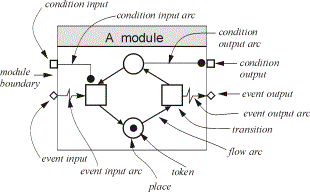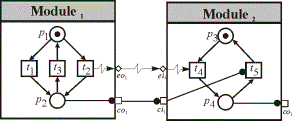
The
formalism
of Net Condition/Event systems exists in several dialects and have been applied
for modeling, verification and synthesis of controllers and control systems of
various types.

Figure
1. Graphical
notation of a module.
From
today's point of view, the general idea which is common to each particular
"dialect" is quite simple, namely the way of thinking of and modeling
a system as a set of modules with a particular dynamic behavior and their
interconnection via signals. This way of modeling is a very intuitive one, and
the modules can be pre-tailored and used over and over again. Each module is
equipped with inputs and outputs which are of two types:
1.
Condition
inputs/outputs carrying state information, and
2.
Event inputs/outputs
carrying state transition information.
This
way of extension of the system with inputs and outputs clearly reflects the
duality of Petri nets, namely the clear distinction between states and states
transitions with their own graphical representation, semantics, and formal
properties. An illustrative example of the graphical notation of a module is
provided in Figure 1
.
Condition
input signals as well as event input signals are connected with transitions
inside the module. Whether a transition of a module fires does not only depend
on the current marking (as it is the case in classical Petri nets) but also on
the incoming condition and event signals. Incoming condition signals
enable/disable a transition by their values in addition to the current marking.
Incoming event signals force transitions to fire if they are enabled by marking
and by condition signals. Hence, we get a modeling concept that can represent
enabling/disabling of transitions by signals as well as enforcing transitions by
signals. More than this, the concept provides a basis for a compositional
approach to build larger models from smaller components. "Composition"
is performed by "glueing" inputs of one module with outputs of another
module as depicted in Figure
2
.

Figure
2. Modular
composition.
Result
of the composition of two NCES N1 and N2 is an NCES Nc
obtained as a union of the components and which can be represented as a new
module. Inputs and outputs of the "composition" are unions of the
components' inputs and outputs, except for those which are interconnected to
each other, and hereby "glued", i.e. substituted by the corresponding
condition and event arcs, as shown in Figure
3
.

Figure
3. Result
of the modular composition.
© 2005, Valeriy V. Vyatkin